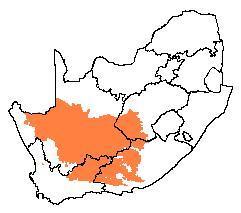NAMA KAROO
Nama Karoo

Nama Karoo occurs on the central plateau of the western half of southern Africa, at altitudes between 500 and 2 000 m, with most of the biome failing between 1 000 and 1 400 m, extending well into central Namibia. It is the second-largest biome in the region.
The geology underlying the biome is varied, as the distribution of this biome is determined primarily by rainfall. The rain fails in summer, and varies between 100 and 520 mm per year. This also determines the predominant soil type - over 80% of the area is covered by a lime-rich, weakly developed soil over rock. Although less than 5% of rain reaches the rivers, the high erodibility of soils poses a major problem where overgrazing occurs.
The dominant vegetation is a grassy, dwarf shrubland. Grasses tend to be more common in depressions and on sandy soils, and less abundant on clayey soils. Grazing rapidly increases the relative abundance of shrubs. Most of the grasses are of the C4 type and, like the shrubs, are deciduous in response to rainfall events.
The amount and nature of the fuel load is insufficient to carry fires and fires are rare within the biome. The large historical herds of Springbok and other game no longer exist. Like the many bird species in the area - mainly larks - the game was probably nomadic between patches of rainfall events within the biome. The Brown Locust and Karoo Caterpillar exhibit eruptions under similarly favourable, local rainfall events, and attract large numbers of bird and mammal predators.
There are very few rare or Red Data Book plant species in the Nama Karoo Biome. Indeed the Cape Peninsula has more species of plants than this entire biome.
Less than 1 % of the biome is conserved in formal areas. The Prickly Pear Opuntia aurantiaca and Mesquite Prosopis glandulosa are the major alien invader species. Urbanization and agriculture are minimal, and irrigation is confined to the Orange River valley and some pans. Most of the land is used for grazing, by sheep (for mutton, wool and pelts) and goats, which can be commensurate with conservation. However, under conditions of overgrazing, many indigenous species may proliferate, including Threethorn Rhigozum trichotomum, Bitterbos Chrysocoma ciliata and Sweet Thorn Acacia karroo, and many grasses and other palatable species may be lost.
Tourism potential is low. Mining is important in the Biome. Most of the research into the dynamics of the biome has been done in the east of the region, with the Grootfontein Agricultural Station at Middelburg featuring prominently. Consequently, little research in the west of the biome has been undertaken.
Source: Low, A.B. & Rebelo, A.(T.) G. 1998. Vegetation of South Africa, Lesotho and. Swaziland, edn 2. Dept of Environmental Affairs and Tourism, Pretoria.





Comments
Add a Comment